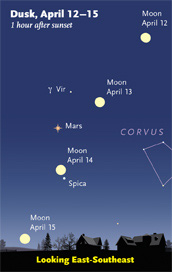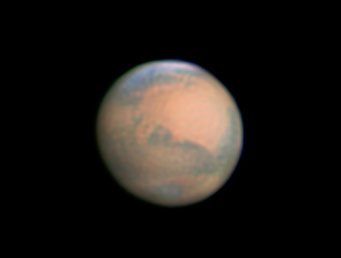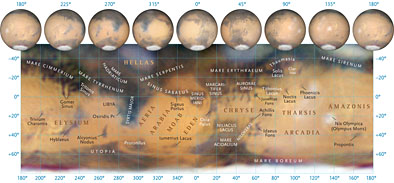Mars is making its nearest and brightest appearance in the night sky since the end of 2007.
| View Mars live! Tonight (April 8th), beginning at 23:00 Universal Time (7:00 p.m. EDT), Gianluca Masi is providing a webcast to show Mars telescopically. Visit his Virtual Telescope Project for details. |

This month we’re closer to Mars than Earth has come for almost 6½ years. The Red Planet appears brighter and bigger in the evening sky than it has since December 2007.
In the middle two weeks of April, Mars will shine at a brightness of magnitude –1.5 (matching Sirius’s bright luster), and in a telescope it will appear 15.1 arcseconds across. That’s still pretty tiny, but it’s larger than Mars has been at its past few oppositions, (The planet will peak out with an apparent width of 24.3 arcseconds in July 2018. Mark your calendars, astronomers!)
Anyone can spot Mars at a glance from anywhere in the world. During April it’s the brightest point in the southeast after dark (as seen from the world’s mid-northern latitudes. In the tropics, look east; in the south temperate latitudes look northeast). Mars is moving though the constellation Virgo near the bright star Spica. This pairing provides a wonderful palette of color for skywatchers following Mars’s night-to-night motion. Mars is the yellow-orange color of a campfire, while Spica shines icy blue-white.

Click for an animation showing a full Martian rotation. Walker created the animation in WinJupos freeware, using 14 of his images taken between Oct. 5 and Dec. 31, 2007, with his 12.5-inch Newtonian telescope. For results like this, WinJupos can map your photos onto a Mercator projection, combine them to cover the complete planet if you have enough of them, then remap the Mercator projection onto a rotating globe. (The little moons zipping across were artificially added by the program.)
S&T: Sean Walker
April 8th is the planet’s opposition date: when it’s opposite the Sun in the sky. It passes closest to Earth several days later on April 14th (the difference is due to the ellipticity of the Martian orbit). But it’s basically the same size and brightness all month. Mars and Spica cross the sky together from dusk until dawn. For telescope users, Mars is highest in the sky due south around 2 a.m. as April begins, and around 11 p.m. as April ends. It will remain bigger than 14.5 arcseconds wide all month.
A 4-inch or larger telescope on a night of steady atmospheric seeing will usually show at least a few light and dark regions, or albedo features, on the planet’s surface. The Martian northern hemisphere is tipped toward Earth this season, which provides a great opportunity for amateur astronomers to track the North Polar Cap as it shrinks in the Martian northern hemisphere’s spring. Backyard observers are already seeing the polar cap recede, exposing the ring of dark ground under its outer parts.

Damien Peach
For more on Mars’s April opposition, including a telescopic Mars map and more to look for, see the March issue of Sky & Telescope magazine.
If you want to observe from the comfort of your own home, there is an online observing session hosted by The Virtual Telescope Project 2.0. The Night of the Red Planet will be hosted on April 8th, 2014 at 11:00 p.m. UT.
And check out the Mars globe from S&T, which maps the full planet using detailed spacecraft images.
 5
5









Comments
Jusin S
April 8, 2014 at 11:27 am
Oh boy! I hope this doesn’t reignite the “Mars is going to look bigger than the moon” hysteria of a few years back. I must have received 100 emails about that. Many people would not believe me when tried to explain the facts!
You must be logged in to post a comment.
gregf61
April 10, 2014 at 1:58 pm
I was disapointed at how it looked through my 8 inch celestron. I knew it wasn't going to be like jupiter or saturn, but basicall all I could see was a red disk with no features...:(
You must be logged in to post a comment.
April 26, 2014 at 12:01 pm
The surface features picture does not enlarge if you click on it. It's much too small to make out.
As for Mars, I agree with gregf61.... I really don't understand how magazines always state you can see details with small scopes. I've read today that a 4 inch is enough to make out the polar cap and largest dark regions. Well not in my view it isn't. I have tried with larger scopes and you can't push the magnification up high enough unless you've got superb class optics.
Can't journalists be more realistic and write for the masses and state how hard it is to get the results they often show? It creates too much frustration for the readers to have such false expectations.
You must be logged in to post a comment.
Raymond
May 7, 2014 at 1:11 pm
This year wasn't a great opposition as it was in 2003. Next really good one will be 2018. When that close, I could see the polar cap with a 60mm refractor, and could see Syrtis Major with my 8 inch Dob. That's by far the easiest dark marking to pick out, because it sticks out like a thumb as can be seen on the map above. Right now, Syrtis Major is facing us about 07:00 UT, I plan to try for it tonight.
Good views of Mars require steady air, and some patience.
You must be logged in to post a comment.
You must be logged in to post a comment.